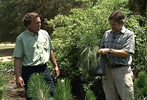Southeastern Channel to air 'The North Shore: Our Natural Legacy'
Contact: Christina Chapple
9/7/07

Click on thumbnail for high resolution photo
Caption …
BACKYARD WONDERS -- Host Charles Reith and Amite horticulturalist Rick Webb talk about the advantages of having native plants in your backyard in "The North Shore: Our Natural Legacy," the latest episode of the Southeastern Channel's nature series, "Backyard Wonders". The program will debut Wednesday, Sept. 12, at 8 p.m. on the Southeastern Channel (Charter Cable Channel 18).
HAMMOND – The rich ecology of the north shore and the impact of human activity on the land is the subject of “The North Shore: Our Natural Legacy,” the latest episode of the Southeastern Channel’s nature series “Backyard Wonders.”
The program will debut Wednesday, Sept. 12, at 8 p.m. on the channel, Southeastern Louisiana University’s educational cable access channel airing on Charter Cable Channel 18. It will be rebroadcast throughout October on Wednesdays at 8 p.m. and Mondays 7 p.m.
“Have you ever wondered what the north shore looked like in its virginal, natural beauty before human visitors, settlers and the resulting land development began taking place?” said channel General Manager Rick Settoon, executive producer of the program. “This show creates appreciation for the beauty of the north shore and the way it was before population growth and rampant new development began taking place. It also shows what needs to be done to protect, and in some cases restore, our area’s natural gifts.”
The program was produced, videotaped and edited by channel staff member Josh Kapusinski and hosted by Charles Reith.
“Ironically, the natural beauty of the north shore has attracted so many visitors and so much development that the native ecology is being damaged,” Reith said. “People need to understand that future development must be more protective of nature or else we will destroy what attracted us here in the first place.”
The program begins with a montage describing the north shore before development, including a look at the region’s sweeping forests, and the threatened longleaf pine savannah tree.
A tour of the Louisiana Nature Conservancy at Covington’s Lake Ramsay Preserve features an interview with Florida Parishes program manager Elwyn McInnis who discusses the conservancy’s mission in protecting the north shore.
Conservancy director Latimore Smith reveals how prescribed fire, a process of burning in natural areas, promotes the growth and ecological health of the savannah and other native species.
“Lake Ramsay contains one of the region’s last premier stands of longleaf pine,” Kapusinski said. “Latimore gives the viewer a rare and up-close opportunity to view a section of the preserve which burned just three days before. Then, he takes them to an area which burned many weeks earlier and examines the stark contrast of growth through beautiful orchids sprouting.”
A trip to the Sandy Hollow Wildlife Management Area near Amite includes an interview with Randy Meyers of the Department of Wildlife and Fisheries and a glimpse of actual fire management in practice.
Reith also takes the viewer to see plants unique to the longleaf pine savannah at the Abita Creek Flatwoods Preserve in Abita Springs. The tour explores carnivorous plants such as the pitcher plant, milkweed and pond cypress, and discusses the threat invasive species have on native plants.
Segments also include the BioBlitz at Tickfaw State Park, an event organized by Southeastern biology graduate students, and a visit to Money Hill Golf and Country Club in Abita Springs, said to be one of the North Shore’s best example of a residential development that has preserved the nature around it. David Goodyear, the development’s owner, discusses the history of Money Hill and how he incorporated nature into his designs.
“The Money Hill residential development is a fascinating place to learn about because it demonstrates what is possible if a developer has a mindset toward protecting nature,” Reith said. “The result of this “natural approach” to development is a great place to live, and not necessarily a more expensive one.”
To bring preservation home to the viewer, Reith interviews horticulturalist Rick Webb at his Amite wholesale nursery, Louisiana Growers. Webb points out native plants that are good for the backyard and restoring the region’s natural legacy.
Reith also demonstrates how to install a native plant in your own backyard.
“One of the most outstanding aspects of this episode is the fact that it covers such a vast topic, yet comes full circle and ends in the backyard,” said Kapusinski. “I think that brings home the underlying theme that people have the control- the option- of restoring our natural legacy one property at a time.”
The Southeastern Channel can be seen on Charter Cable Channel 18 in Tangipahoa, St. Tammany and Livingston parishes and on Channel 17 in Washington Parish. It can be seen online at www.selu.edu/tv.
More News...
